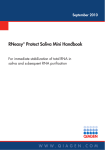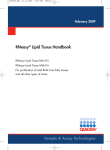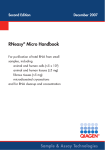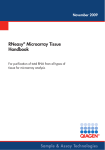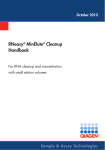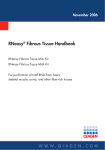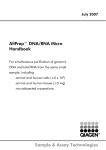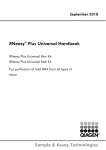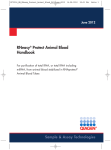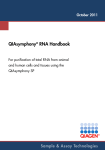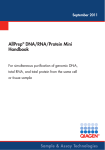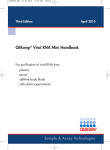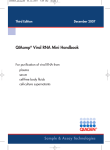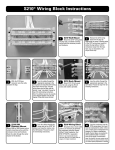Download RNAprotect® Cell Reagent Handbook
Transcript
Second Edition October 2010 RNAprotect® Cell Reagent Handbook RNAprotect Cell Reagent For immediate stabilization of nucleic acids in cells RNeasy® Protect Cell Mini Kit For immediate stabilization of nucleic acids in cells and subsequent total RNA purification Sample & Assay Technologies Trademarks: QIAGEN®, QIAamp®, QIAcube®, AllPrep®, Allprotect™, DNeasy®, MinElute®, Quantiscript®, QuantiTect®, RNAprotect®, RNeasy®, TissueRuptor® (QIAGEN Group); Applied Biosystems® (Applera Corporation or its subsidiaries); Agilent® (Agilent Technologies, Inc.); LightCycler® (Roche Group); PAXgene™ (PreAnalytiX GmbH); SYBR® (Molecular Probes, Inc.). “RNAlater®” is a trademark of AMBION, Inc., Austin, Texas and is covered by various U.S. and foreign patents. © 2006–2010 QIAGEN, all rights reserved. Contents Kit Contents 4 Storage 5 Quality Control 5 Product Use Limitations 5 Product Warranty and Satisfaction Guarantee 5 Technical Assistance 6 Safety Information 6 Introduction 8 Principle and procedure 8 Description of protocols 9 Automated purification Equipment and Reagents to Be Supplied by User Important Notes Determining the amount of starting material 10 12 13 13 Protocols Stabilization of Nucleic Acids in Sorted or Cultured Cells Using RNAprotect Cell Reagent Purification of RNA from RNAprotect Stabilized Cells Using the RNeasy Plus Mini Kit 15 17 Troubleshooting Guide 22 Appendix A: General Remarks on Handling RNA 26 Appendix B: Storage, Quantification, and Determination of Quality of RNA 28 Appendix C: Preparing RNAprotect Stabilized Cells for Simultaneous DNA and RNA Purification 31 Appendix D: Preparing RNAprotect Stabilized Cells for DNA Purification 33 Ordering Information 35 RNAprotect Cell Reagent Handbook 10/2010 3 Kit Contents RNAprotect Cell Reagent (250 ml) Catalog no. 76526 RNAprotect Cell Reagent 250 ml RNAprotect Cell Reagent Handbook 1 RNeasy Protect Cell Mini Kit (50) Catalog no. 74624 Number of preps 50 RNAprotect Cell Reagent (box 1 of 2): RNAprotect Cell Reagent 50 ml RNAprotect Cell Reagent Handbook* 1 RNeasy Plus Mini Kit (box 2 of 2): gDNA Eliminator Mini Spin Columns (uncolored) (each in a 2 ml Collection Tube) 50 RNeasy Mini Spin Columns (pink) (each in a 2 ml Collection Tube) 50 Collection Tubes (1.5 ml) 50 Collection Tubes (2 ml) 50 Buffer RLT Plus Buffer RW1 † 45 ml † 45 ml Buffer RPE‡ (concentrate) 11 ml RNase-Free Water 10 ml RNeasy Plus Mini Handbook* 1 * Follow the instructions in the RNAprotect Cell Reagent Handbook when stabilizing and purifying RNA from cells. † Contains a guanidine salt. Not compatible with disinfectants containing bleach. See page 6 for safety information. ‡ Before using for the first time, add 4 volumes of ethanol (96–100%) as indicated on the bottle to obtain a working solution. 4 RNAprotect Cell Reagent Handbook 10/2010 Storage Store RNAprotect Cell Reagent at room temperature (15–25°C). The reagent is stable for at least 12 months under these conditions. The RNeasy Plus Mini Kit should be stored dry at room temperature (15–25°C) and is stable for at least 9 months under these conditions. Quality Control In accordance with QIAGEN’s ISO-certified Quality Management System, each lot of RNAprotect Cell Reagent and RNeasy Protect Cell Mini Kit is tested against predetermined specifications to ensure consistent product quality. Product Use Limitations The RNAprotect Cell Reagent and the RNeasy Protect Cell Mini Kit are intended for molecular biology applications. These products are not intended for the diagnosis, prevention, or treatment of a disease. All due care and attention should be exercised in the handling of the products. We recommend all users of QIAGEN® products to adhere to the NIH guidelines that have been developed for recombinant DNA experiments, or to other applicable guidelines. Product Warranty and Satisfaction Guarantee QIAGEN guarantees the performance of all products in the manner described in our product literature. The purchaser must determine the suitability of the product for its particular use. Should any product fail to perform satisfactorily due to any reason other than misuse, QIAGEN will replace it free of charge or refund the purchase price. We reserve the right to change, alter, or modify any product to enhance its performance and design. If a QIAGEN product does not meet your expectations, simply call your local Technical Service Department or distributor. We will credit your account or exchange the product — as you wish. Separate conditions apply to QIAGEN scientific instruments, service products, and to products shipped on dry ice. Please inquire for more information. A copy of QIAGEN terms and conditions can be obtained on request, and is also provided on the back of our invoices. If you have questions about product specifications or performance, please call QIAGEN Technical Services or your local distributor (see back cover or visit www.qiagen.com ). RNAprotect Cell Reagent Handbook 10/2010 5 Technical Assistance At QIAGEN, we pride ourselves on the quality and availability of our technical support. Our Technical Service Departments are staffed by experienced scientists with extensive practical and theoretical expertise in sample and assay technologies and the use of QIAGEN products. If you have any questions or experience any difficulties regarding RNAprotect Cell Reagent, the RNeasy Protect Cell Mini Kit, or QIAGEN products in general, please do not hesitate to contact us. QIAGEN customers are a major source of information regarding advanced or specialized uses of our products. This information is helpful to other scientists as well as to the researchers at QIAGEN. We therefore encourage you to contact us if you have any suggestions about product performance or new applications and techniques. For technical assistance and more information, please see our Technical Support Center at www.qiagen.com/goto/TechSupportCenter or call one of the QIAGEN Technical Service Departments or local distributors (see back cover or visit www.qiagen.com ). Safety Information When working with chemicals, always wear a suitable lab coat, disposable gloves, and protective goggles. For more information, please consult the appropriate material safety data sheets (MSDSs). These are available online in convenient and compact PDF format at www.qiagen.com/Support/MSDS.aspx where you can find, view, and print the MSDS for each QIAGEN kit and kit component. CAUTION: DO NOT add bleach or acidic solutions directly to the sample-preparation waste. Buffer RLT Plus contains guanidine thiocyanate and Buffer RW1 contains a small amount of guanidine thiocyanate. This chemical can form highly reactive compounds when combined with bleach. If liquid containing these buffers is spilt, clean with suitable laboratory detergent and water. If the spilt liquid contains potentially infectious agents, clean the affected area first with laboratory detergent and water, and then with 1% (v/v) sodium hypochlorite. 6 RNAprotect Cell Reagent Handbook 10/2010 The following risk and safety phrases apply to RNAprotect Cell Reagent and the components of the RNeasy Protect Cell Mini Kit. RNAprotect Cell Reagent Contains tetradecyltrimethylammonium oxalate: irritant, dangerous for the environment. Risk and safety phrases:* R43-51/53, S36/37/39-61 Buffer RLT Plus Contains guanidine thiocyanate: harmful. Risk and safety phrases:* R20/21/22-32, S13-26-36-46 Buffer RW1 Contains ethanol: flammable. Risk phrase:* R10 24-hour emergency information Emergency medical information in English, French, and German can be obtained 24 hours a day from: Poison Information Center Mainz, Germany Tel: +49-6131-19240 * R10: Flammable; R20/21/22: Harmful by inhalation, in contact with skin and if swallowed; R32: Contact with acids liberates very toxic gas; R43: May cause sensitization by skin contact; R51/53: Toxic to aquatic organisms, may cause long-term adverse effects in the aquatic environment; S13: Keep away from food, drink and animal feedingstuffs; S26: In case of contact with eyes, rinse immediately with plenty of water and seek medical advice; S36: Wear suitable protective clothing; S36/37/39: Wear suitable protective clothing, gloves and eye/face protection; S46: If swallowed, seek medical advice immediately and show the container or label; S61: Avoid release to the environment. Refer to special instructions/safety data sheets. RNAprotect Cell Reagent Handbook 10/2010 7 Introduction The RNeasy Protect Cell procedure provides a complete solution for the stabilization and purification of total RNA from sorted or cultured cells. RNA in cells is immediately stabilized using RNAprotect Cell Reagent, and then rapidly purified using the RNeasy Plus Mini Kit, which includes gDNA Eliminator columns for rapid, effective removal of genomic DNA contamination. The stabilized cells can be shipped at ambient temperature prior to RNA purification; no dry ice is required. RNAprotect Cell Reagent also stabilizes DNA in cells. The stabilized DNA can be purified using QIAGEN kits for DNA purification such as DNeasy® Kits and QIAamp® Kits. Alternatively, stabilized DNA and RNA can be purified simultaneously from the same cell sample using an AllPrep® Kit. Principle and procedure RNA stabilization using RNAprotect Cell Reagent Immediate stabilization of RNA in sorted or cultured cells is generally a prerequisite for reliable gene expression analysis using microarray, real-time RT-PCR, or other nucleic acid-based technology. This is because changes in the gene expression pattern occur immediately after harvesting due to unspecific and specific RNA degradation as well as to transcriptional induction. RNAprotect Cell Reagent uses a novel patent-pending technology to immediately stabilize the gene expression profile in cells. With other technologies, it is necessary to wash or process the cells (e.g., trypsin treatment) prior to adding RNA stabilization reagent. However, changes in gene expression may occur during the washing or processing steps. In contrast, RNAprotect Cell Reagent can be added directly to cells in culture medium or buffer, providing instantaneous RNA stabilization. The reagent can also be used to treat cells not in medium or storage solution, such as pelleted cells. After stabilization in RNAprotect Cell Reagent, cells can be conveniently stored and transported at ambient temperature with the cellular RNA remaining intact and undegraded. RNAprotect Cell Reagent also enables stabilization of DNA, providing simultaneous stabilization of RNA and DNA in the same cell sample. RNA purification using the RNeasy Plus Mini Kit The RNeasy Plus Mini Kit integrates QIAGEN’s patented technology for selective removal of double-stranded DNA with well-established RNeasy technology. Efficient purification of high-quality RNA is guaranteed, without the need for additional DNase digestion. 8 RNAprotect Cell Reagent Handbook 10/2010 Cells stabilized in RNAprotect Cell Reagent are centrifuged and the resulting pellet is lysed and homogenized in a highly denaturing guanidine-thiocyanate–containing buffer, which immediately inactivates RNases to ensure isolation of intact RNA. The lysate is then passed through a gDNA Eliminator spin column. This column, in combination with the optimized high-salt buffer, allows efficient removal of genomic DNA. Ethanol is added to the flow-through to provide appropriate binding conditions for RNA, and the sample is then applied to an RNeasy spin column, where total RNA binds to the membrane and contaminants are efficiently washed away. High-quality RNA is then eluted in 30 µl, or more, of RNase-free water. With the RNeasy Plus Mini Kit, all RNA molecules longer than 200 nucleotides are purified. The procedure provides an enrichment for mRNA, since most RNAs <200 nucleotides (such as 5.8S rRNA, 5S rRNA, and tRNAs, which together comprise 15–20% of total RNA) are selectively excluded. The size distribution of the purified RNA is comparable to that obtained by centrifugation through a CsCl cushion, where small RNAs do not sediment efficiently. The RNeasy Plus Mini Kit provides RNA purification from up to 1 x 107 cells. For very small cell samples, we recommend using the RNeasy Plus Micro Kit (see page 36 for ordering information), which enables RNA purification from up to 5 x 105 cells with an elution volume of as low as 10 µl. Description of protocols Stabilization of Nucleic Acids in Sorted or Cultured Cells Using RNAprotect Cell Reagent This protocol describes how to add RNAprotect Cell Reagent to sorted or cultured cells for immediate, simultaneous stabilization of RNA and DNA. Purification of RNA from RNAprotect Stabilized Cells Using the RNeasy Plus Mini Kit This protocol describes how to purify RNA from sorted or cultured cells that have been stabilized in RNAprotect Cell Reagent. The protocol requires use of the RNeasy Plus Mini Kit (included in the RNeasy Protect Cell Mini Kit). If purifying RNA from very small cell samples using the RNeasy Plus Micro Kit (see page 36 for ordering information), follow the cell protocol in the RNeasy Plus Micro Handbook. RNAprotect Cell Reagent Handbook 10/2010 9 Specialized protocols The appendices contain specialized protocols for preparing sorted or cultured cells stabilized in RNAprotect Cell Reagent for subsequent DNA purification. Appendix C (page 31) describes how to prepare RNAprotect stabilized cells for simultaneous purification of DNA and RNA using an AllPrep Kit. Appendix D (page 33) describes how to prepare RNAprotect stabilized cells for DNA purification using a DNeasy Kit or QIAamp Kit. Automated purification Purification of RNA can be fully automated on the QIAcube®. The innovative QIAcube uses advanced technology to process QIAGEN spin columns, enabling seamless integration of automated, low-throughput sample prep into your laboratory workflow. Sample preparation using the QIAcube follows the same steps as the manual procedure (i.e., lyse, bind, wash, and elute) enabling you to continue using the RNeasy Plus Mini Kit for purification of high-quality RNA. For more information about the automated procedure, see the relevant protocol sheet available at www.qiagen.com/MyQIAcube . The QIAcube is preinstalled with protocols for purification of plasmid DNA, genomic DNA, RNA, viral nucleic acids, and proteins, plus DNA and RNA cleanup. The range of protocols available is continually expanding, and additional QIAGEN protocols can be downloaded free of charge at www.qiagen.com/MyQIAcube . 10 RNAprotect Cell Reagent Handbook 10/2010 RNeasy Protect Cell Procedure Cells Genomic DNA Total RNA Total RNA Eluted RNA RNAprotect Cell Reagent Handbook 10/2010 11 Equipment and Reagents to Be Supplied by User When working with chemicals, always wear a suitable lab coat, disposable gloves, and protective goggles. For more information, consult the appropriate material safety data sheets (MSDSs), available from the product supplier. Sterile, RNase-free pipet tips Centrifuge and appropriately sized centrifuge tubes for centrifugation of stabilized cells Microcentrifuge (with rotor for 2 ml tubes) Vortexer Ethanol (70% and 96–100%)* Disposable gloves Equipment for cell homogenization: we recommend either QIAshredder homogenizers or the TissueRuptor® with TissueRuptor Disposable Probes (see ordering information, page 35) Optional: 14.3 M β-mercaptoethanol (β-ME) (commercially available solutions are usually 14.3 M) * Do not use denatured alcohol, which contains other substances such as methanol or methylethylketone. 12 RNAprotect Cell Reagent Handbook 10/2010 Important Notes Determining the amount of starting material It is essential to use the correct amount of starting material in order to obtain optimal RNA yield and purity. The maximum amount that can be used is limited by: The volume of RNAprotect Cell Reagent required for cell stabilization The cell type and its RNA content The volume of Buffer RLT Plus required for efficient cell lysis The DNA removal capacity of the gDNA Eliminator spin column The RNA binding capacity of the RNeasy spin column Effective cell stabilization requires the mixing of 5 volumes of RNAprotect Cell Reagent with 1 volume of cell culture or buffer or 1 volume of pelleted cells, but the cell number should not be too high. In addition, the maximum volume of Buffer RLT Plus that can be used limits the maximum amount of starting material to 1 x 107 cells. Since RNA content can vary greatly between cell types, we recommend starting with no more than 3–4 x 106 cells. Depending on RNA integrity, yield, and purity, it may be possible to increase the cell number up to 1 x 107 cells in subsequent preparations. The amount of starting material must not exceed the maximum of 1 x 107 cells, even if the RNA binding capacity of the RNeasy spin column (100 µg RNA) will not be reached. Otherwise, lysis will be incomplete and cellular debris may interfere with the binding of RNA to the RNeasy spin column membrane, resulting in lower RNA yield and purity. If the binding capacity of the RNeasy spin column is exceeded, RNA yields will not be consistent and may also be reduced. If the DNA removal capacity of the gDNA Eliminator spin column is exceeded, the purified RNA will be contaminated with DNA. Although the gDNA Eliminator spin column can bind more than 100 µg DNA, we recommend using samples containing less than 20 µg DNA to ensure removal of virtually all genomic DNA. Counting cells is the most accurate way to quantitate the amount of starting material. As a guide, Table 1 shows the number of HeLa cells obtained in various culture vessels after confluent growth. RNAprotect Cell Reagent Handbook 10/2010 13 Table 1. Growth area and number of HeLa cells in various culture vessels Cell-culture vessel Growth area (cm2)* Number of cells† 96-well 0.32–0.6 4–5 x 104 48-well 1 1 x 105 24-well 2 2.5 x 105 12-well 4 5 x 105 9.5 1 x 106 35 mm 8 1 x 106 60 mm 21 2.5 x 106 100 mm 56 7 x 106 145 2 x 107 40–50 ml 25 3 x 106 250–300 ml 75 1 x 107 650–750 ml 162–175 2 x 107 Multiwell plates 6-well Dishes 145–150 mm Flasks * Per well, if multiwell plates are used; varies slightly depending on the supplier. † Cell numbers are given for HeLa cells (approximate length = 15 µm), assuming confluent growth. Cell numbers will vary for different kinds of animal cells, which vary in length from 10 to 30 µm. 14 RNAprotect Cell Reagent Handbook 10/2010 Protocol: Stabilization of Nucleic Acids in Sorted or Cultured Cells Using RNAprotect Cell Reagent Important points before starting If using RNAprotect Cell Reagent for the first time, read “Important Notes” (page 13). If DNA or DNA/RNA will be purified, refer also to the relevant section in the DNeasy, QIAamp, or AllPrep handbook on determining the amount of starting material. Nucleic acids in cells are not protected until the cells are mixed with a sufficient volume of RNAprotect Cell Reagent. The reagent should be added immediately to pelleted cells or should be added directly to cells in medium or storage solution. Be sure to mix cells with a sufficient volume of RNAprotect Cell Reagent, as described in the procedure below. Smaller volumes may lead to nucleic acid degradation during storage and reduced RNA and DNA yields. Larger volumes can be used if necessary or desired. If adding RNAprotect Cell Reagent directly to cells that are in a large volume of medium or storage solution, the pelleting of the cells for nucleic acid purification (page 17, 31, or 33) may be incomplete, leading to reduced RNA and DNA yields. When processing high numbers of cells, we recommend a volume of 1 ml or less for the medium or storage solution. In general, we recommed lower volumes, especially for low numbers of cells. Standard cell lines, such as HeLa cells, Jurkat cells, and macrophages, do not lyse in RNAprotect Cell Reagent. However, some cell lines may lyse in the reagent, releasing nucleic acids into solution. Although the released RNA and DNA remain stabilized, they need to be collected in a cell pellet prior to nucleic acid purification (page 17, 31, or 33). To maximize recovery of the released RNA and DNA, we recommend using lower volumes of medium or storage solution if possible. Only fresh, unfrozen cells can be stabilized using RNAprotect Cell Reagent. Perform the procedure described below as quickly as possible. RNAprotect Cell Reagent Handbook 10/2010 15 Stabilization This protocol describes how to stabilize RNA and DNA in different cell formats. RNAprotect Cell Reagent can be added directly to cells (adherent or suspension) in medium or storage solution (e.g., PBS). Alternatively, the reagent can be added to cells not in medium or storage solution, such as pelleted cells. Procedure Stabilization 1. Add RNAprotect Cell Reagent to cells according to step 1a or 1b. 1a. Cells in solution or cells covered with solution: Add 5 volumes of RNAprotect Cell Reagent to 1 volume of cell-culture medium or storage solution. Mix by shaking, pipetting, or vortexing. Note: The medium or storage solution must not exceed 1 ml. We recommend lower volumes, especially if the cells are susceptible to lysis in RNAprotect Cell Reagent. Adherent cells will detach after addition of RNAprotect Cell Reagent. No trypsin treatment is necessary. During storage of the stabilized cells, material may sink to the bottom of the storage vessel. To avoid having to resuspend this material, we recommend transferring the cells to a centrifuge tube (for use in step 1 of the protocol on page 17, 31, or 33) after adding the reagent. 1b. Pelleted cells or other cells not covered with solution (e.g., smears): Add 300 µl RNAprotect Cell Reagent to the cell pellet in a centrifuge tube (not supplied). Resuspend the cells completely by vortexing. Note: Be sure to add at least 5 volumes of RNAprotect Cell Reagent to the cell pellet. If residual culture medium or buffer increases the overall volume to over 60 µl, increase the amount of RNAprotect Cell Reagent accordingly. Note: Larger volumes of RNAprotect Cell Reagent can be added if desired. 2. Store the mix of cells and RNAprotect Cell Reagent for up to 1 day at 30°C, up to 7 days at room temperature (15–25°C), or up to 4 weeks at 2–8°C, or archive at –20°C or –80°C. Note: We recommend lower storage temperatures whenever possible (e.g., 2–8°C instead of room temperature, or room temperature instead of 30°C). Note: A precipitate may form during storage, especially at lower temperatures. This does not affect RNA and DNA purification. 16 RNAprotect Cell Reagent Handbook 10/2010 Protocol: Purification of RNA from RNAprotect Stabilized Cells Using the RNeasy Plus Mini Kit Disrupting and homogenizing starting material Efficient disruption and homogenization of the starting material is an absolute requirement for all total RNA purification procedures. Disruption and homogenization are 2 distinct steps: Homogenization: Homogenization is necessary to reduce the viscosity of the lysates produced by disruption. Homogenization shears high-molecular-weight genomic DNA and other high-molecular-weight cellular components to create a homogeneous lysate. Incomplete homogenization results in inefficient binding of RNA to the RNeasy spin column membrane and therefore significantly reduced RNA yields. With the RNeasy procedure, disruption of cultured cells is achieved by thorough vortexing in Buffer RLT Plus. Homogenization is then carried out using either QIAshredder homogenizers or the TissueRuptor: QIAshredder homogenizers provide a fast and efficient way to homogenize cell lysates without cross-contamination of samples. Up to 700 µl of lysate is loaded onto a QIAshredder spin column placed in a 2 ml collection tube, and spun for 2 minutes at full speed in a microcentrifuge. The lysate is homogenized as it passes through the spin column. The TissueRuptor is a rotor–stator homogenizer that can be used to homogenize cell lysates. The blade of the TissueRuptor disposable probe rotates at a very high speed, causing the sample to be homogenized by a combination of turbulence and mechanical shearing. Be sure to use a suitably sized vessel to hold the sample and to keep the tip of the probe submerged during homogenization. Generally, round-bottomed tubes allow more efficient homogenization than conical-bottomed tubes. For guidelines on homogenization using the TissueRuptor, refer to the TissueRuptor Handbook. For other rotor–stator homogenizers, refer to suppliers’ guidelines. Important points before starting If using the RNeasy Protect Cell Mini Kit for the first time, read “Important Notes” (page 13). If working with RNA for the first time, read Appendix A (page 26). If using the TissueRuptor, ensure that you are familiar with operating it by referring to the TissueRuptor User Manual and TissueRuptor Handbook. RNAprotect Cell Reagent Handbook 10/2010 17 RNA Purification Disruption: Complete disruption of plasma membranes of cells and organelles is absolutely required to release all the RNA contained in the sample. Incomplete disruption results in significantly reduced RNA yields. Buffer RLT Plus may form a precipitate during storage. If necessary, redissolve by warming, and then place at room temperature (15–25°C). Buffer RLT Plus and Buffer RW1 contain a guanidine salt and are therefore not compatible with disinfecting reagents containing bleach. See page 6 for safety information. RNA Purification Perform all steps of the procedure at room temperature. During the procedure, work quickly. Perform all spin column centrifugation steps at 20–25°C in a standard microcentrifuge. Ensure that the centrifuge does not cool below 20°C. Things to do before starting Buffer RPE is supplied as a concentrate. Before using for the first time, add 4 volumes of ethanol (96–100%) as indicated on the bottle to obtain a working solution. Many common cell lines such as HeLa and Jurkat cells do not require β-mercaptoethanol (β-ME) for RNA purification. However, β-ME may help to avoid RNA degradation during RNA purification from some cell lines. In this case, add 10 µl β-ME per 1 ml Buffer RLT Plus before use. Dispense in a fume hood and wear appropriate protective clothing. Buffer RLT Plus containing β-ME can be stored at room temperature (15–25°C) for up to 1 month. Procedure 1. Centrifuge the mix of cells and RNAprotect Cell Reagent for 5 min at 5000 x g in an appropriately sized centrifuge tube. If transferring the sample to the centrifuge tube from a storage vessel, be sure to resuspend any material deposited at the bottom of the vessel by vortexing or by pipetting up and down. It is important to transfer all sample material to the centrifuge tube, otherwise RNA yields will be reduced. Note: If the sample was stored at below room temperature (e.g., –20°C), thaw it completely before starting centrifugation. Note: A precipitate may form during storage, especially at lower temperatures. This does not affect RNA purification. 2. Remove the supernatant completely by pipetting. 3. Loosen the pellet by flicking the tube. Loosening the pellet facilitates dissolving in Buffer RLT Plus in step 4. 4. Add 350 µl or 600 µl Buffer RLT Plus (see Table 2). Dissolve the pellet completely by vortexing and proceed immediately to step 5. 18 RNAprotect Cell Reagent Handbook 10/2010 If necessary, add β-ME to Buffer RLT Plus before use (see “Things to do before starting”). Note: Be sure to dissolve the pellet completely. This can take about 1 min. Incomplete dissolving may lead to inefficient lysis and reduced RNA yields. Note: The dissolved pellet may be turbid. This does not affect RNA purification. Table 2. Volumes of Buffer RLT Plus for lysing cells Number of cells Volume of Buffer RLT Plus (µl) 350 <5 x 10 6 5 x 10 – 1 x 10 6 5. 7 600 Homogenize the lysate according to step 5a or 5b. See “Disrupting and homogenizing starting material”, page 17, for more details on homogenization. Note: Incomplete homogenization leads to significantly reduced RNA yields and can cause clogging of the RNeasy spin column. 5a. Pipet the lysate directly into a QIAshredder spin column placed in a 2 ml collection tube, and centrifuge for 2 min at full speed. Proceed to step 6. 5b. Homogenize the lysate for 30 s using the TissueRuptor. Proceed to step 6. 6. Transfer the homogenized lysate to a gDNA Eliminator spin column placed in a 2 ml collection tube (supplied). Centrifuge for 30 s at ⱖ8000 x g (ⱖ10,000 rpm). Discard the column, and save the flow-through. Note: Make sure that no liquid remains on the column membrane after centrifugation. If necessary, repeat the centrifugation until all liquid has passed through the membrane. 7. Add 1 volume of 70% ethanol to the flow-through, and mix well by pipetting. Do not centrifuge. The volume of flow-through may be less than 350 µl or 600 µl due to loss during homogenization and DNA removal. Note: When purifying RNA from certain cell lines, precipitates may be visible after addition of ethanol. This does not affect the procedure. RNAprotect Cell Reagent Handbook 10/2010 19 RNA Purification The dissolved pellet can be stored at –70°C for several months. After removal from storage, incubate the dissolved pellet at room temperature or at 37°C in a water bath until completely thawed and salts are dissolved. Avoid prolonged incubation at 37°C, which can cause RNA degradation. Proceed to step 5. 8. Transfer up to 700 µl of the sample, including any precipitate that may have formed, to an RNeasy spin column placed in a 2 ml collection tube (supplied). Close the lid gently, and centrifuge for 15 s at ⱖ8000 x g (ⱖ10,000 rpm). Discard the flow-through.* Reuse the collection tube in step 9. RNA Purification If the sample volume exceeds 700 µl, centrifuge successive aliquots in the same RNeasy spin column. Discard the flow-through after each centrifugation. 9. Add 700 µl Buffer RW1 to the RNeasy spin column. Close the lid gently, and centrifuge for 15 s at ⱖ8000 x g (ⱖ10,000 rpm) to wash the spin column membrane. Discard the flow-through.* Reuse the collection tube in step 10. Note: After centrifugation, carefully remove the RNeasy spin column from the collection tube so that the column does not contact the flow-through. Be sure to empty the collection tube completely. 10. Add 500 µl Buffer RPE to the RNeasy spin column. Close the lid gently, and centrifuge for 15 s at ⱖ8000 x g (ⱖ10,000 rpm) to wash the spin column membrane. Discard the flow-through. Reuse the collection tube in step 11. Note: Buffer RPE is supplied as a concentrate. Ensure that ethanol is added to Buffer RPE before use (see “Things to do before starting”). 11. Add 500 µl Buffer RPE to the RNeasy spin column. Close the lid gently, and centrifuge for 2 min at ⱖ8000 x g (ⱖ10,000 rpm) to wash the spin column membrane. The long centrifugation dries the spin column membrane, ensuring that no ethanol is carried over during RNA elution. Residual ethanol may interfere with downstream reactions. Note: After centrifugation, carefully remove the RNeasy spin column from the collection tube so that the column does not contact the flow-through. Otherwise, carryover of ethanol will occur. 12. Optional: Place the RNeasy spin column in a new 2 ml collection tube (supplied), and discard the old collection tube with the flow-through. Centrifuge at full speed for 1 min. Perform this step to eliminate any possible carryover of Buffer RPE or if residual flow-through remains on the outside of the RNeasy spin column after step 11. * Flow-through contains Buffer RLT Plus or Buffer RW1 and is therefore not compatible with bleach. See page 6 for safety information. 20 RNAprotect Cell Reagent Handbook 10/2010 13. Place the RNeasy spin column in a new 1.5 ml collection tube (supplied). Add 30–50 µl RNase-free water directly to the spin column membrane. Close the lid gently, and centrifuge for 1 min at ⱖ8000 x g (ⱖ10,000 rpm) to elute the RNA. 14. If the expected RNA yield is >30 µg, repeat step 13 using another 30–50 µl of RNase-free water, or using the eluate from step 13 (if high RNA concentration is required). Reuse the collection tube from step 13. For RT-PCR and real-time RT-PCR with the purified RNA, QIAGEN offers a range of optimized, ready-to-use kits that provide highly specific and sensitive results. For details, visit www.qiagen.com/PCR . RNAprotect Cell Reagent Handbook 10/2010 21 RNA Purification If using the eluate from step 13, the RNA yield will be 15–30% less than that obtained using a second volume of RNase-free water, but the final RNA concentration will be higher. Troubleshooting Guide This troubleshooting guide may be helpful in solving any problems that may arise. The scientists in QIAGEN Technical Services are always happy to answer any questions you may have about either the information and protocols in this handbook or sample and assay technologies (for contact information, see back cover or visit www.qiagen.com ). Comments and suggestions Nucleic acids degraded a) Cells not immediately stabilized Mix the cells immediately with RNAprotect Cell Reagent. b) Prolonged storage Cells mixed with RNAprotect Cell Reagent can be stored for up to 1 day at 30°C, up to 7 days at 15–25°C, or up to 4 weeks at 2–8°C, or archived at –20°C or –80°C. We recommend lower storage temperatures whenever possible. c) RNA degradation during RNA purification Although all RNeasy buffers have been tested and are guaranteed RNase-free, RNases can be introduced during use. Be careful not to introduce any RNases during RNA purification or later handling. See Appendix A (page 26) for general remarks on handling RNA. Clogged gDNA Eliminator spin column a) Inefficient disruption and/or homogenization See “Disrupting and homogenizing starting material” (page 17) for details on disruption and homogenization. Increase g-force and centrifugation time if necessary. In subsequent preparations, reduce the amount of starting material (see page 13) and/or increase the homogenization time. b) 22 Too much starting material Reduce the amount of starting material. It is essential to use the correct amount of starting material (see page 13). RNAprotect Cell Reagent Handbook 10/2010 Comments and suggestions c) Centrifugation temperature too low The centrifugation temperature should be 20–25°C. Some centrifuges may cool to below 20°C even when set at 20°C. This can cause formation of precipitates that can clog the gDNA Eliminator spin column. If this happens, set the centrifugation temperature to 25°C. Warm the lysate to 37°C before transferring it to the gDNA Eliminator spin column. Low RNA yield a) Insufficient disruption and homogenization See “Disrupting and homogenizing starting material” (page 17) for details on disruption and homogenization. In subsequent preparations, reduce the amount of starting material (see page 13) and/or increase the volume of lysis buffer and the homogenization time. b) Too much starting material Overloading the RNeasy spin column significantly reduces RNA yield. Reduce the amount of starting material (see page 13). c) Ethanol added to lysate before DNA removal Pass the lysate through the gDNA Eliminator spin column before adding ethanol to it. d) RNA still bound to RNeasy spin column membrane Repeat RNA elution, but incubate the RNeasy spin column on the benchtop for 10 min with RNase-free water before centrifuging. e) Ethanol carryover During the second wash with Buffer RPE, be sure to centrifuge at ⱖ8000 x g (ⱖ10,000 rpm) for 2 min at 20–25°C to dry the RNeasy spin column membrane. Perform the optional centrifugation to dry the RNeasy spin column membrane if any flowthrough is present on the outside of the column (step 12 of the second protocol, page 17). f) Incomplete removal of RNAprotect Cell Reagent RNAprotect Cell Reagent Handbook 10/2010 Be sure to remove any excess RNAprotect Cell Reagent to prevent significant dilution of Buffer RLT Plus. Sample lysis will be impaired if the lysis buffer is diluted. 23 Comments and suggestions g) Cells in too large a volume of medium or storage solution (e.g., PBS) In subsequent preparations, reduce the volume of medium or storage solution. Low A260/A280 value Water used to dilute RNA for A260/A280 measurement Use 10 mM Tris·Cl, pH 7.5, not RNase-free water, to dilute the sample before measuring purity (see Appendix B, page 28). DNA contamination in downstream experiments a) Cell number too high For some cell types, the efficiency of DNA removal may be reduced when processing very high cell numbers (containing more than 20 µg genomic DNA). If the eluted RNA contains substantial DNA contamination, try processing smaller cell numbers. b) Incomplete removal of RNAprotect Cell Reagent Be sure to remove any excess RNAprotect Cell Reagent to prevent significant dilution of Buffer RLT Plus. The gDNA Eliminator spin column will not work effectively if the lysis buffer is diluted. RNA concentration too low Elution volume too high Elute RNA with less than 2 x 50 µl of water. Do not use less than 1 x 30 µl of water. Although eluting with less than 2 x 50 µl of water results in increased RNA concentrations, RNA yields may be reduced. RNA does not perform well in downstream experiments a) Salt carryover during elution Ensure that Buffer RPE is at 20–30°C. When reusing collection tubes between washing steps, remove residual flow-through from the rim by blotting on clean paper towels. 24 RNAprotect Cell Reagent Handbook 10/2010 Comments and suggestions b) Ethanol carryover During the second wash with Buffer RPE, be sure to centrifuge at ⱖ8000 x g (ⱖ10,000 rpm) for 2 min at 20–25°C to dry the RNeasy spin column membrane. After centrifugation, carefully remove the column from the collection tube so that the column does not contact the flow-through. Otherwise, carryover of ethanol will occur. Perform the optional centrifugation to dry the RNeasy spin column membrane if any flowthrough is present on the outside of the column (step 12 of the second protocol, page 17). RNAprotect Cell Reagent Handbook 10/2010 25 Appendix A: General Remarks on Handling RNA Handling RNA Ribonucleases (RNases) are very stable and active enzymes that generally do not require cofactors to function. Since RNases are difficult to inactivate and even minute amounts are sufficient to destroy RNA, do not use any plasticware or glassware without first eliminating possible RNase contamination. Great care should be taken to avoid inadvertently introducing RNases into the RNA sample during or after the purification procedure. In order to create and maintain an RNase-free environment, the following precautions must be taken during pretreatment and use of disposable and nondisposable vessels and solutions while working with RNA. General handling Proper microbiological, aseptic technique should always be used when working with RNA. Hands and dust particles may carry bacteria and molds and are the most common sources of RNase contamination. Always wear latex or vinyl gloves while handling reagents and RNA samples to prevent RNase contamination from the surface of the skin or from dusty laboratory equipment. Change gloves frequently and keep tubes closed whenever possible. Keep purified RNA on ice when aliquots are pipetted for downstream applications. Disposable plasticware The use of sterile, disposable polypropylene tubes is recommended throughout the procedure. These tubes are generally RNase-free and do not require pretreatment to inactivate RNases. Nondisposable plasticware Nondisposable plasticware should be treated before use to ensure that it is RNase-free. Plasticware should be thoroughly rinsed with 0.1 M NaOH,* 1 mM EDTA* followed by RNase-free water (see “Solutions”, page 27). Alternatively, chloroform-resistant plasticware can be rinsed with chloroform* to inactivate RNases. * When working with chemicals, always wear a suitable lab coat, disposable gloves, and protective goggles. For more information, consult the appropriate material safety data sheets (MSDSs), available from the product supplier. 26 RNAprotect Cell Reagent Handbook 10/2010 Glassware Glassware should be treated before use to ensure that it is RNase-free. Glassware used for RNA work should be cleaned with a detergent,* thoroughly rinsed, and oven baked at 240°C for at least 4 hours (overnight, if more convenient) before use. Autoclaving alone will not fully inactivate many RNases. Alternatively, glassware can be treated with DEPC* (diethyl pyrocarbonate). Fill glassware with 0.1% DEPC (0.1% in water), allow to stand overnight (12 hours) at 37°C, and then autoclave or heat to 100°C for 15 minutes to eliminate residual DEPC. Electrophoresis tanks Electrophoresis tanks should be cleaned with detergent solution (e.g., 0.5% SDS),* thoroughly rinsed with RNase-free water, and then rinsed with ethanol† and allowed to dry. Solutions Solutions (water and other solutions) should be treated with 0.1% DEPC. DEPC is a strong, but not absolute, inhibitor of RNases. It is commonly used at a concentration of 0.1% to inactivate RNases on glass or plasticware or to create RNase-free solutions and water. DEPC inactivates RNases by covalent modification. Add 0.1 ml DEPC to 100 ml of the solution to be treated and shake vigorously to bring the DEPC into solution. Let the solution incubate for 12 hours at 37°C. Autoclave for 15 minutes to remove any trace of DEPC. DEPC will react with primary amines and cannot be used directly to treat Tris* buffers. DEPC is highly unstable in the presence of Tris buffers and decomposes rapidly into ethanol and CO2. When preparing Tris buffers, treat water with DEPC first, and then dissolve Tris to make the appropriate buffer. Trace amounts of DEPC will modify purine residues in RNA by carbethoxylation. Carbethoxylated RNA is translated with very low efficiency in cell-free systems. However, its ability to form DNA:RNA or RNA:RNA hybrids is not seriously affected unless a large fraction of the purine residues have been modified. Residual DEPC must always be eliminated from solutions or vessels by autoclaving or heating to 100°C for 15 minutes. Note: RNeasy buffers are guaranteed RNase-free without using DEPC treatment and are therefore free of any DEPC contamination. * When working with chemicals, always wear a suitable lab coat, disposable gloves, and protective goggles. For more information, consult the appropriate material safety data sheets (MSDSs), available from the product supplier. † Plastics used for some electrophoresis tanks are not resistant to ethanol. Take proper care and check the supplier’s instructions. RNAprotect Cell Reagent Handbook 10/2010 27 Appendix B: Storage, Quantification, and Determination of Quality of RNA Storage of RNA Purified RNA may be stored at –20°C or –70°C in RNase-free water. Under these conditions, no degradation of RNA is detectable after 1 year. Quantification of RNA The concentration of RNA should be determined by measuring the absorbance at 260 nm (A260) in a spectrophotometer (see “Spectrophotometric quantification of RNA” below). For small amounts of RNA, however, it may be difficult to determine amounts photometrically. Small amounts of RNA can be accurately quantified using an Agilent® 2100 bioanalyzer, quantitative RT-PCR, or fluorometric quantification. Spectrophotometric quantification of RNA To ensure significance, A260 readings should be greater than 0.15. An absorbance of 1 unit at 260 nm corresponds to 44 µg of RNA per ml (A260=1 → 44 µg/ml). This relation is valid only for measurements at a neutral pH. Therefore, if it is necessary to dilute the RNA sample, this should be done in a buffer with neutral pH.* As discussed below (see “Purity of RNA”, page 29), the ratio between the absorbance values at 260 and 280 nm gives an estimate of RNA purity. When measuring RNA samples, be certain that cuvettes are RNase-free, especially if the RNA is to be recovered after spectrophotometry. This can be accomplished by washing cuvettes with 0.1 M NaOH,* 1 mM EDTA,* followed by washing with RNase-free water (see “Solutions”, page 27). Use the buffer in which the RNA is diluted to zero the spectrophotometer. An example of the calculation involved in RNA quantification is shown below: Volume of RNA sample = 100 µl Dilution = 10 µl of RNA sample + 490 µl of 10 mM Tris·Cl,* pH 7.0 (1/50 dilution) Measure absorbance of diluted sample in a 1 ml cuvette (RNase-free) A260 = 0.2 Concentration of RNA sample = 44 µg/ml x A260 x dilution factor = 44 µg/ml x 0.2 x 50 = 440 µg/ml * When working with chemicals, always wear a suitable lab coat, disposable gloves, and protective goggles. For more information, consult the appropriate material safety data sheets (MSDSs), available from the product supplier. 28 RNAprotect Cell Reagent Handbook 10/2010 Total amount = concentration x volume in milliliters = 440 µg/ml x 0.1 ml = 44 µg of RNA Purity of RNA The ratio of the readings at 260 nm and 280 nm (A260/A280) provides an estimate of the purity of RNA with respect to contaminants that absorb in the UV spectrum, such as protein. However, the A260/A280 ratio is influenced considerably by pH. Since water is not buffered, the pH and the resulting A260/A280 ratio can vary greatly. Lower pH results in a lower A260/A280 ratio and reduced sensitivity to protein contamination.* For accurate values, we recommend measuring absorbance in 10 mM Tris·Cl, pH 7.5. Pure RNA has an A260/A280 ratio of 1.9–2.1† in 10 mM Tris·Cl, pH 7.5. Always be sure to calibrate the spectrophotometer with the same solution used for dilution. For determination of RNA concentration, however, we recommend dilution of the sample in a buffer with neutral pH since the relationship between absorbance and concentration (A260 reading of 1 = 44 µg/ml RNA) is based on an extinction coefficient calculated for RNA at neutral pH (see “Spectrophotometric quantification of RNA”, page 28). DNA contamination No currently available purification method can guarantee that RNA is completely free of DNA, even when it is not visible on an agarose gel. While the RNeasy Plus Mini Kit will remove the vast majority of cellular DNA, trace amounts may still remain, depending on the amount and nature of the sample. For analysis of very low abundance targets, any interference by residual DNA contamination can be detected by performing real-time RT-PCR control experiments in which no reverse transcriptase is added prior to the PCR step. To prevent any interference by DNA in real-time RT-PCR applications, such as with Applied Biosystems® and LightCycler® instruments, we recommend designing primers that anneal at intron splice junctions so that genomic DNA will not be amplified. QuantiTect® Primer Assays from QIAGEN are designed for SYBR® Green based realtime RT-PCR analysis of RNA sequences (without detection of genomic DNA) where possible. * Wilfinger, W.W., Mackey, M., and Chomczynski, P. (1997) Effect of pH and ionic strength on the spectrophotometric assessment of nucleic acid purity. BioTechniques 22, 474. † Values up to 2.3 are routinely obtained for pure RNA (in 10 mM Tris·Cl, pH 7.5) with some spectrophotometers. RNAprotect Cell Reagent Handbook 10/2010 29 Integrity of RNA The integrity and size distribution of total RNA purified with RNeasy Kits can be checked by denaturing agarose gel electrophoresis and ethidium bromide* staining or by using an Agilent 2100 bioanalyzer. The respective ribosomal RNAs should appear as sharp bands or peaks. The apparent ratio of 28S rRNA to 18S RNA should be approximately 2:1. If the ribosomal bands or peaks of a specific sample are not sharp, but appear as a smear towards smaller sized RNAs, it is likely that the sample suffered major degradation either before or during RNA purification. * When working with chemicals, always wear a suitable lab coat, disposable gloves, and protective goggles. For more information, consult the appropriate material safety data sheets (MSDSs), available from the product supplier. 30 RNAprotect Cell Reagent Handbook 10/2010 Appendix C: Preparing RNAprotect Stabilized Cells for Simultaneous DNA and RNA Purification This specialized protocol describes how to prepare cultured or sorted cells stabilized in RNAprotect Cell Reagent for the simultaneous purification of DNA and RNA. The purification procedure requires the use of an AllPrep Kit, such as the AllPrep DNA/RNA Micro Kit or AllPrep DNA/RNA Mini Kit (see page 36 for ordering information). Separate eluates of RNA and DNA are simultaneously purified from the same sample. Important points before starting If using the AllPrep Kit for the first time, carefully read the handbook supplied with the kit, especially the “Safety Information” and “Important Notes” sections, and determine the appropriate number of cells to be processed. Buffer RLT Plus (supplied with the AllPrep Kit) contains a guanidine salt and is therefore not compatible with disinfecting reagents containing bleach. See the AllPrep handbook for safety information. Perform all steps of the procedure at room temperature (15–25°C). During the procedure, work quickly. Perform all spin column centrifugation steps at 20–25°C in a standard microcentrifuge. Ensure that the centrifuge does not cool below 20°C. Should any problems arise, refer to “Nucleic acids degraded” on page 22 and also to the troubleshooting guide in the AllPrep handbook. Things to do before starting Buffer RLT Plus may form a precipitate during storage. If necessary, redissolve by warming, and then place at room temperature (15–25°C). Many common cell lines such as HeLa and Jurkat cells do not require β-mercaptoethanol* (β-ME) for RNA purification. However, β-ME may help to avoid RNA degradation during RNA purification from some cell lines. In this case, add 10 µl β-ME per 1 ml Buffer RLT Plus before use. Dispense in a fume hood and wear appropriate protective clothing. Buffer RLT Plus containing β-ME can be stored at room temperature (15–25°C) for up to 1 month. * When working with chemicals, always wear a suitable lab coat, disposable gloves, and protective goggles. For more information, consult the appropriate material safety data sheets (MSDSs), available from the product supplier. RNAprotect Cell Reagent Handbook 10/2010 31 Procedure 1. Centrifuge the mix of cells and RNAprotect Cell Reagent for 5 min at 5000 x g in an appropriately sized centrifuge tube. If transferring the sample to the centrifuge tube from a storage vessel, be sure to resuspend any material deposited at the bottom of the vessel by vortexing or by pipetting up and down. It is important to transfer all sample material to the centrifuge tube, otherwise DNA and RNA yields will be reduced. Note: If the sample was stored at below room temperature (e.g., –20°C), thaw it completely before starting centrifugation. Note: A precipitate may form during storage, especially at lower temperatures. This does not affect DNA and RNA purification. 2. Remove the supernatant completely by pipetting. 3. Loosen the pellet by flicking the tube. Loosening the pellet facilitates dissolving in Buffer RLT Plus in step 4. 4. Add 350 µl or 600 µl Buffer RLT Plus (see Table 3). Dissolve the pellet completely by vortexing. If necessary, add β-ME to Buffer RLT Plus before use (see “Things to do before starting”). Note: Be sure to dissolve the pellet completely. This can take about 1 min. Incomplete dissolving may lead to inefficient lysis and reduced DNA and RNA yields. Note: The dissolved pellet may be turbid. This does not affect DNA and RNA purification. The dissolved pellet can be stored at –70°C for several months. After removal from storage, incubate the dissolved pellet at room temperature or at 37°C in a water bath until completely thawed and salts are dissolved. Avoid prolonged incubation at 37°C, which can cause RNA degradation. Proceed to step 5. Table 3. Volumes of Buffer RLT Plus for lysing pelleted cells Number of pelleted cells 5 x 10 – 1 x 10 6 Volume of Buffer RLT Plus 350 µl <5 x 10 6 7 600 µl 5. Proceed immediately with homogenization and DNA and RNA purification according to the cell protocol in the AllPrep handbook. 32 RNAprotect Cell Reagent Handbook 10/2010 Appendix D: Preparing RNAprotect Stabilized Cells for DNA Purification This specialized protocol describes how to prepare cultured or sorted cells stabilized in RNAprotect Cell Reagent for the purification of DNA. The purification procedure requires the use of the DNeasy Blood & Tissue Kit, QIAamp DNA Mini Kit, or other similar QIAGEN kit for genomic DNA purification from animal or human cells (see page 36 for ordering information). Important points before starting If using the DNeasy Kit or QIAamp Kit for the first time, carefully read the handbook supplied with the kit, especially the “Safety Information” and “Important Notes” sections, and determine the appropriate number of cells to be processed. Buffer AL (supplied with the DNeasy or QIAamp Kit) contains a guanidine salt and is therefore not compatible with disinfecting reagents containing bleach. See the DNeasy or QIAamp handbook for safety information. The first step of the procedure requires the use of PBS (50 mM potassium phosphate, 150 mM NaCl, pH 7.2).* The fourth step of the procedure requires the optional use of RNase A* (see page 36 for ordering information). Perform all steps of the procedure at room temperature (15–25°C). During the procedure, work quickly. Perform all spin column centrifugation steps at 20–25°C in a standard microcentrifuge. Ensure that the centrifuge does not cool below 20°C. Vortexing should be performed by pulse-vortexing for 5–10 s. Should any problems arise, refer to “Nucleic acids degraded” on page 22 and also to the troubleshooting guide in the DNeasy or QIAamp handbook. Things to do before starting Buffer AL may form a precipitate during storage. If necessary, warm to 56°C until the precipitate has fully dissolved. Preheat a thermomixer, shaking water bath, or rocking platform to 56°C for use in step 5. * When working with chemicals, always wear a suitable lab coat, disposable gloves, and protective goggles. For more information, consult the appropriate material safety data sheets (MSDSs), available from the product supplier. RNAprotect Cell Reagent Handbook 10/2010 33 Procedure 1. Centrifuge the mix of cells and RNAprotect Cell Reagent for 5 min at 5000 x g in an appropriately sized centrifuge tube. If transferring the sample to the centrifuge tube from a storage vessel, be sure to resuspend any material deposited at the bottom of the vessel by vortexing or by pipetting up and down. It is important to transfer all sample material to the centrifuge tube, otherwise DNA yields will be reduced. Note: If the sample was stored at below room temperature (e.g., –20°C), thaw it completely before starting centrifugation. Note: A precipitate may form during storage, especially at lower temperatures. This does not affect DNA purification. 2. Remove the supernatant completely by pipetting. 3. Loosen the pellet by flicking the tube. Loosening the pellet facilitates dissolving in PBS in step 4. 4. Add 200 µl PBS, and dissolve the pellet completely by vortexing. Add 20 µl proteinase K (supplied with the DNeasy or QIAamp Kit). Ensure that an appropriate number of cells is used in the procedure. For cell lines with a high degree of ploidy (e.g., HeLa cells), we recommend using less than the maximum number of cells specified in the DNeasy or QIAamp handbook. Note: Be sure to dissolve the pellet completely. This can take about 1 min. Incomplete dissolving may lead to inefficient lysis and reduced DNA yields. Note: The dissolved pellet may be turbid. This does not affect DNA purification. Optional: If RNA-free genomic DNA is required, add 4 µl RNase A (100 mg/ml), mix by vortexing, and incubate for 2 min at room temperature (15–25°C) before continuing with step 5. 5. Add 200 µl Buffer AL (without added ethanol). Mix thoroughly by vortexing, and incubate at 56°C for 10 min. Ensure that ethanol has not been added to Buffer AL. Buffer AL can be purchased seperately (see page 35 for ordering information). It is essential that the sample and Buffer AL are mixed immediately and thoroughly by vortexing or pipetting to yield a homogeneous solution. 6. Proceed with adding ethanol (200 µl) and applying the sample to the DNeasy or QIAamp spin column according to the blood protocol in the DNeasy or QIAamp handbook. 34 RNAprotect Cell Reagent Handbook 10/2010 Ordering Information Product Contents Cat. no. RNAprotect Cell Reagent (250 ml) 250 ml RNAprotect Cell Reagent 76526 RNeasy Protect Cell Mini Kit (50) RNAprotect Cell Reagent (50 ml) and RNeasy Plus Mini Kit (50) 74624 RNeasy Plus Mini Kit (50) 50 RNeasy Mini Spin Columns, 50 gDNA Eliminator Mini Spin Columns, Collection Tubes, RNase-Free Reagents and Buffers 74134 Collection Tubes (2 ml) 1000 x 2 ml Collection Tubes 19201 QIAshredder (50) 50 disposable cell-lysate homogenizers 79654 QIAshredder (250) 250 disposable cell-lysate homogenizers 79656 Accessories TissueRuptor (115 V, 50–60 Hz) Handheld rotor–stator homogenizer, 115 V, 50–60 Hz, for North America and Japan 9001271 TissueRuptor (235 V, 50/60 Hz) Handheld rotor–stator homogenizer, 235 V, 50/60 Hz, for Europe (excluding UK and Ireland) 9001272 TissueRuptor (235 V, 50/60 Hz) Handheld rotor–stator homogenizer, 235 V, 50/60 Hz, for UK and Ireland 9001273 TissueRuptor (235 V, 50/60 Hz) Handheld rotor–stator homogenizer, 235 V, 50/60 Hz, for Australia 9001274 TissueRuptor Disposable Probes (25) 25 nonsterile plastic disposable probes for use with the TissueRuptor Buffer AL (216 ml) 216 ml lysis buffer for use in DNA purification 19075 QIAGEN Proteinase K (2 ml) 2 ml proteinase K solution (>600 mAU/ml) for use in DNA purification 19131 QIAGEN Proteinase K (10 ml) 10 ml proteinase K solution (>600 mAU/ml) for use in DNA purification 19133 RNAprotect Cell Reagent Handbook 10/2010 990890 35 Ordering Information Product RNase A (17,500 U) Contents Cat. no. 2.5 ml RNase A solution (100 mg/ml; 7000 units/ml) 19101 Related products for sample purification RNeasy Plus Micro Kit — for purification of total RNA from small cell and tissue samples using gDNA Eliminator columns RNeasy Plus Micro Kit (50) For 50 micropreps: RNeasy MinElute® Spin Columns, gDNA Eliminator Spin Columns, Collection Tubes, Carrier RNA, RNase-Free Water and Buffers 74034 AllPrep DNA/RNA Kits — for simultaneous purification of genomic DNA and total RNA from the same cell or tissue sample AllPrep DNA/RNA Micro Kit (50) For 50 micropreps: AllPrep DNA Spin Columns, RNeasy MinElute Spin Columns, Collection Tubes, Carrier RNA, RNase-Free Water and Buffers 80284 AllPrep DNA/RNA Mini Kit (50) For 50 minipreps: AllPrep DNA Spin Columns, RNeasy Mini Spin Columns, Collection Tubes, RNase-Free Water and Buffers 80204 DNeasy Blood & Tissue Kit — for purification of total DNA from animal blood and tissues, and from cells, yeast, bacteria, or viruses DNeasy Blood & Tissue Kit (50) For 50 minipreps: DNeasy Mini Spin Columns, Proteinase K, Buffers, Collection Tubes 69504 DNeasy Blood & Tissue Kit (250) 69506 For 250 minipreps: DNeasy Mini Spin Columns, Proteinase K, Buffers, Collection Tubes QIAamp DNA Mini Kit — for purification of genomic, mitochondrial, bacterial, parasite, or viral DNA from human samples QIAamp DNA Mini Kit (50) 36 For 50 minipreps: QIAamp Mini Spin Columns, Proteinase K, Buffers, Collection Tubes 51304 RNAprotect Cell Reagent Handbook 10/2010 Ordering Information Product QIAamp DNA Mini Kit (250) Contents Cat. no. For 250 minipreps: QIAamp Mini Spin Columns, Proteinase K, Buffers, Collection Tubes 51306 Related products for sample stabilization and purification Allprotect™ Tissue Reagent — for immediate stabilization of DNA, RNA, and protein in animal and human tissues Allprotect Tissue Reagent (100 ml) 100 ml Allprotect Tissue Reagent, Allprotect Reagent Pump 76405 RNAlater® RNA Stabilization Reagent — for immediate stabilization of the gene expression profile in harvested tissues RNAlater RNA Stabilization Reagent (50 ml)* For stabilization of RNA in 25 x 200 mg tissue samples: 50 ml RNAlater RNA Stabilization Reagent 76104 RNAlater TissueProtect Tubes — for collecting harvested tissues with immediate stabilization of the gene expression profile, and subsequent transport and storage RNAlater TissueProtect Tubes (50 x 1.5 ml)* For stabilization of RNA in 50 x 150 mg tissue samples: 50 screw-top tubes containing 1.5 ml RNAlater RNA Stabilization Reagent each 76154 RNeasy Protect Mini Kit — for immediate stabilization of the gene expression profile in tissues and subsequent RNA purification RNeasy Protect Mini Kit (50)* RNAlater RNA Stabilization Reagent (50 ml), 50 RNeasy Mini Spin Columns, Collection Tubes, RNase-Free Reagents and Buffers 74124 RNAprotect Bacteria Reagent — for in vivo stabilization of the gene expression profile in bacteria RNAprotect Bacteria Reagent RNAprotect Bacteria Reagent (2 x 100 ml) 76506 * Larger kit size and/or format available; see www.qiagen.com/RNA . RNAprotect Cell Reagent Handbook 10/2010 37 Ordering Information Product Contents Cat. no. RNeasy Protect Bacteria Mini Kit — for in vivo stabilization of the gene expression profile in bacteria and subsequent RNA purification RNeasy Protect Bacteria Mini Kit (50)* RNeasy Mini Kit (50) and RNAprotect Bacteria Reagent (2 x 100 ml) 74524 RNeasy Protect Saliva Mini Kit — for immediate stabilization of RNA in saliva and subsequent total RNA purification RNeasy Protect Saliva Mini Kit (50) RNAprotect Saliva Reagent (50 ml) and RNeasy Micro Kit (50) 74324 PAXgene™ Blood RNA Kit — for isolation and purification of intracellular RNA from whole blood stabilized in PAXgene Blood RNA Tubes PAXgene Blood RNA Kit (50) 50 PAXgene Spin Columns, 762164‡ 50 PAXgene Shredder Spin Columns, 762174§ Processing Tubes, RNase-Free DNase I, RNase-Free Reagents and Buffers. To be used in conjunction with PAXgene Blood RNA Tubes† PAXgene Bone Marrow RNA System — for storage and transport of bone marrow samples and stabilization and purification of intracellular RNA PAXgene Bone Marrow RNA Tubes (50) 50 Bone Marrow Collection Tubes. To be used in conjunction with the PAXgene Bone Marrow RNA Kit 764114 PAXgene Bone Marrow RNA Kit (30) For 30 RNA preps: 30 PAXgene Spin Columns, 30 PAXgene Shredder Spin Columns, Processing Tubes, RNase-Free DNase I, RNase-Free Reagents and Buffers. To be used in conjunction with PAXgene Bone Marrow RNA Tubes 764133 * Larger kit format available; see www.qiagen.com/RNA . † PAXgene Blood RNA Tubes can be ordered from BD and BD authorized distributors ( www.bd.com ). ‡ Canada and USA only. § Rest of the world; kit not available in all countries. 38 RNAprotect Cell Reagent Handbook 10/2010 Ordering Information Product Contents Cat. no. QuantiTect Reverse Transcription Kit — for fast cDNA synthesis for sensitive real-time two-step RT-PCR QuantiTect Reverse Transcription Kit (50)* For 50 x 20 µl reactions: gDNA Wipeout Buffer, Quantiscript® Reverse Transcriptase, Quantiscript RT Buffer, RT Primer Mix, RNase-Free Water 205311 QuantiTect Primer Assays — for use in real-time RT-PCR with SYBR Green detection (search for and order assays at www.qiagen.com/GeneGlobe ) QuantiTect Primer Assay (200) For 200 x 50 µl reactions or 400 x 25 µl reactions: 10x QuantiTect Primer Assay (lyophilized) Varies For up-to-date licensing information and product-specific disclaimers, see the respective QIAGEN kit handbook or user manual. QIAGEN kit handbooks and user manuals are available at www.qiagen.com or can be requested from QIAGEN Technical Services or your local distributor. * Larger kit size available; see www.qiagen.com/PCR . RNAprotect Cell Reagent Handbook 10/2010 39 www.qiagen.com Australia I Orders 1-800-243-800 I Fax 03-9840-9888 I Technical 1-800-243-066 Austria I Orders 0800-28-10-10 I Fax 0800/28-10-19 I Technical 0800-28-10-11 Belgium I Orders 0800-79612 I Fax 0800-79611 I Technical 0800-79556 Brazil I Orders 0800-557779 I Fax 55-11-5079-4001 I Technical 0800-557779 Canada I Orders 800-572-9613 I Fax 800-713-5951 I Technical 800-DNA-PREP (800-362-7737) China I Orders 86-21-3865-3865 I Fax 86-21-3865-3965 I Technical 800-988-0325 Denmark I Orders 80-885945 I Fax 80-885944 I Technical 80-885942 Finland I Orders 0800-914416 I Fax 0800-914415 I Technical 0800-914413 France I Orders 01-60-920-926 I Fax 01-60-920-925 I Technical 01-60-920-930 I Offers 01-60-920-928 Germany I Orders 02103-29-12000 I Fax 02103-29-22000 I Technical 02103-29-12400 Hong Kong I Orders 800 933 965 I Fax 800 930 439 I Technical 800 930 425 Ireland I Orders 1800 555 049 I Fax 1800 555 048 I Technical 1800 555 061 Italy I Orders 800-789-544 I Fax 02-334304-826 I Technical 800-787980 Japan I Telephone 03-6890-7300 I Fax 03-5547-0818 I Technical 03-6890-7300 Korea (South) I Orders 080-000-7146 I Fax 02-2626-5703 I Technical 080-000-7145 Luxembourg I Orders 8002-2076 I Fax 8002-2073 I Technical 8002-2067 Mexico I Orders 01-800-7742-639 I Fax 01-800-1122-330 I Technical 01-800-7742-436 The Netherlands I Orders 0800-0229592 I Fax 0800-0229593 I Technical 0800-0229602 Norway I Orders 800-18859 I Fax 800-18817 I Technical 800-18712 Singapore I Orders 1800-742-4362 I Fax 65-6854-8184 I Technical 1800-742-4368 Spain I Orders 91-630-7050 I Fax 91-630-5145 I Technical 91-630-7050 Sweden I Orders 020-790282 I Fax 020-790582 I Technical 020-798328 Switzerland I Orders 055-254-22-11 I Fax 055-254-22-13 I Technical 055-254-22-12 UK I Orders 01293-422-911 I Fax 01293-422-922 I Technical 01293-422-999 USA I Orders 800-426-8157 I Fax 800-718-2056 I Technical 800-DNA-PREP (800-362-7737) 1064935 10/2010 Sample & Assay Technologies








































